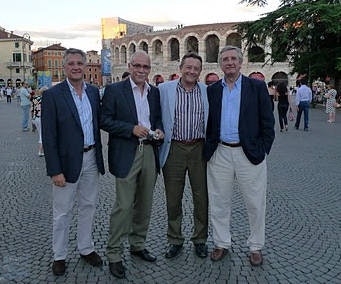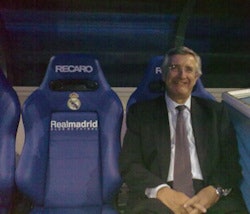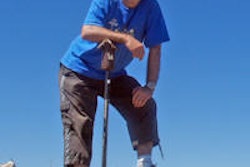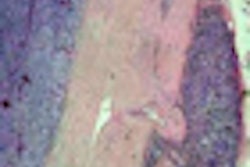
Later this week in Granada, Dr. Eduardo Fraile Moreno will stand down as president of the Spanish Society of Radiology (SERAM). To mark the occasion, he spoke exclusively with AuntMinnieEurope.com about the status of radiology in his country and the future challenges facing the specialty.
AuntMinnieEurope.com: In which clinical areas do Spanish radiologists tend to excel?
Fraile Moreno: I think there are several areas, but abdominal and interventional radiology are the most important. We have a strong department of imaging at the Hospital University Clinic in Barcelona, which is a leader in hepatic pathology and liver transplants and where radiologists work closely with colleagues from different specialties. There are several top interventional radiology groups in Spain, and at the Clinica Universitaria de Navarra in Pamplona, Dr. José Ignacio Bilbao is a real expert in interventional body radiology.
 On the culture trail: Senior Spanish radiologists enjoy the atmosphere before attending an opera performance in Verona, Italy. From the left are: Dr. Luís Donoso Bach from Barcelona, Dr. Francisco Tardáguila Montero from Vigo, Dr. Luis Martí-Bonmatí from Valencia, and Dr. Eduardo Fraile Moreno from Madrid. All images courtesy of Dr. Fraile.
On the culture trail: Senior Spanish radiologists enjoy the atmosphere before attending an opera performance in Verona, Italy. From the left are: Dr. Luís Donoso Bach from Barcelona, Dr. Francisco Tardáguila Montero from Vigo, Dr. Luis Martí-Bonmatí from Valencia, and Dr. Eduardo Fraile Moreno from Madrid. All images courtesy of Dr. Fraile.Spanish radiologists tend to be less strong in cardiac imaging due to its complicated and technical requirements. Our society is running training courses to improve knowledge of this area.
What do you regard as the greatest single challenge facing radiology in Spain?
The integration with other specialties like nuclear medicine and cardiology. Ultrasound demand in Spain is very strong, and limits upon radiologists mean that other specialties are performing studies without adequate knowledge. Also, we are facing a challenge over the integration of primary healthcare in our departments, and it is necessary to establish protocols and adequate demand for studies.
Is there a surplus of radiologists in your country at present?
This year we have a balance between specialists and jobs, but I don't what will happen in the future. Every year, around 200 residents finish their training and perhaps we need to increase the number of subspecialists in some regions.
 Dr. Eduardo Fraile Moreno.
Dr. Eduardo Fraile Moreno.Teleradiology and PACS appear to be used increasingly. Do you welcome this trend?
It is true that the use of teleradiology in our country is growing, and this is due to the quality of our specialists and technological development. To ensure there are sufficient safeguards, we are working with the European Society of Radiology (ESR) to develop and implement rules and regulations for this new type of radiology work.
For the past five years, all new faculties have opened as full digital departments, but now given the economic situation, the digital conversion of all hospitals is going more slowly. There are several regional PACS, as at the Universidad de Castilla-La Mancha and in Madrid, where recently PACS was installed at the Unidad Central de Radiodiagnostico and six other hospitals that provide radiological support for around 1.1 million inhabitants.
Is there a national breast screening program?
Our healthcare system is divided into 17 geographical areas, each of which is an autonomous community. Each area has a screening program with different levels of development. In general, all start at 50 years of age, with annual revisions and double reading of examinations.
How is radiology training and education organized?
We have a national system of training support that lasts for a period of four years, but we are working to increase this by one year more. We think this is absolutely necessary to bring us into line with other countries and for the future development of our specialty.
SERAM's congress begins in Granada on 24 May. What will be the central themes? What's new this year?
 Fraile Moreno is a passionate fan of Real Madrid Football Club. He is shown here in the dugout at the club's home ground, the Estádio de Santiago Bernabéu, which is the third largest stadium in Europe and has a capacity of more than 80,000 seats.
Fraile Moreno is a passionate fan of Real Madrid Football Club. He is shown here in the dugout at the club's home ground, the Estádio de Santiago Bernabéu, which is the third largest stadium in Europe and has a capacity of more than 80,000 seats.Functional oncologic imaging and head and neck pathology will be important topics this year. Also, there will be concurrent sessions in 11 separate rooms during the four days that the congress lasts, and the sessions will be divided by organ system with refresher courses, conferences, oral communications, and around 1,200 electronic posters.
During the congress, I will become the past president, and Doctora Carmen Ayuso will become the president of our society. For the last two years during which I have been president, the society had increased its grants to radiologists, raised the impact factor of our journal, Radiologia, increased the number of international members, and increased the relations with other societies like the American Roentgen Ray Society (ARRS) and ESR. Today SERAM is a strong scientific society with a solid structure and economic stability.
For all of us, it will be a great honor for Dr. [José] Bilbao to be president during the next European congress. Our participation in European radiology has increased during the past few years, and for us, this is recognition of the work done by many Spanish colleagues.
Overall, are you optimistic about the future of radiology in Spain?
Of course, I am very optimistic about the future of our specialty in Spain. I am also optimistic about the position of radiology in healthcare, and I think it will become more and more significant. We have a lot of challenges, but I am sure that we can overcome all of them.



















